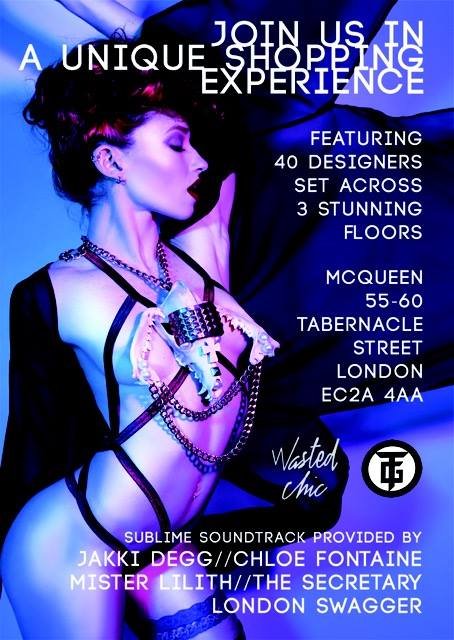
Tag: Modern kilts
Join Skilt at the Boutique Bazzar this Sunday in London
Fast becoming a destination for stylists, models, performers and dramatic fashionistas of all types, Torture Garden & Wasted Chic present the fourth instalment of a new shopping experience aimed at those with unconventional tastes…Featuring a curated selection of underground fashion & all things daring- think couture latex, custom corsetry, elaborate headresses, tempting lingerie, luxury leather, and exotic jewels….set across 3 floors in sumptuous & award-winning venue McQueen Shoreditch, we also have premium cocktails for just £5 & a sublime soundtrack provided by Torture Garden & Wasted Chic DJs to add to the fun.
Designers will be selling items for immediate purchase on the day, but will also be taking deposits for pre-order, allowing you a chance to meet with them, see samples in the flesh, and discuss your requirements, making purchasing that special item even easier…..a great opportunity to purchase something unique in time for those Torture Garden’s Birthday Ball, Belle Epoque, springtime soirees or your naughty nights in.
**Those that have come ‘Dressed to Impress’ will be invited into our pop-up portrait studio to have their look captured by our talented in house photographer, Gothic Image**
£7 entry on the door
£5 entry if you let me know today (Thursday) so I can put you on our guest list
See you there!
Azeem Ibrahim: Why We Need an Islamic Tartan
[slideshow]Meaningful symbols bring people in communities together. National flags, for example, play an important part in raising community awareness and pride. The flag of St. Andrew’s cross or the Saltire is as familiar in immigrant communities in Scotland as the crescent of Islam, with allegiance to both being a powerful component of citizenship.
As a Scottish Muslim, I am deeply involved in the dynamics of community and the exploration of values of national and ethnic pride. Current discussion of independence and the future referendum is bringing a new focus to what it means to be a Scot, and Muslim communities in Scotland are particularly sensitive to the complexities of culture, race and religion that are perceived as an integral part of Scottishness. Generations who have known no other home than Scotland now have a primary allegiance to this country rather than the nations where their parents or grandparents may have been born.
Therefore the idea of a Scottish Islamic Tartan seemed to me to be the perfect symbol of the future generation in particular, for the younger, educated Muslims caught between two cultures — East and West, traditional and modern. Instead of conflict, the tartan represents a tightly woven blend of tradition and heritage. By bringing together the strands of two cultures, a symbol is created of something more meaningful than assimilation or accommodation. The tartan represents the new fabric of society, where Muslim Scots with a sense of history and a commitment to the future of Scotland have become an integral part of the New Scotland.
With the design and introduction of a Muslim tartan, I hope to interest, challenge and provoke discussion among people who have Scotland’s interests at heart. The exclusion of Muslim communities has never been in the country’s interest and Scotland’s future, whether devolved or independent, depends on every Scot playing a part in creating a peaceful and successful homeland. What more fitting symbol of this aspiration than an Islamic Tartan?
Trend-spotting: Men In Skirts – Forbes
One of the more surprising trends to emerge from the Men’s Spring-Summer 2012 runway shows that just ended in Paris: skirts. Long, short, narrow, baggy, pleated, fringed — they came in all shapes and styles. Most seemed like a provocation or statement. Riccardo Tisci’s boxy skirts at Givenchy were printed with vaguely vaginal close-ups of bird-of-paradise flowers that made one think of Georgia O’Keeffe. Rei Kawakubo’s calf-length dresses at Comme des Garcons were a shocking Pepto-Bismol pink. Rick Owens’ hobble skirts were dour and monk-like — and looked like they would be very difficult to walk in.
Japanese designer Yohji Yamamoto’s versions, however, were so appealing they could actually pose a threat to slacks’ dominance in menswear. The diverse cast of models — from beefy, bearded blokes to fresh-faced youth to small, wise-looking elders — looked supremely confident and comfortable in their baggy, samurai skirts and wide, pleated culottes that looked like skirts.
The kilt is to the emancipation of men as trousers were to the emancipation of women
We believe that, in addition to looking and feeling great, the kilt is a symbol of the mature masculine. A mature man is a man who has faced his emotions, stood up, and freed himself from the social expectations of the old fashioned macho man.
Kate Luck explores the relationship between trousers and feminism in the book ‘The Gendered Object‘:
‘In 1851, Elizabeth Cady Stanton and Amelia Bloomer, two leading American feminist writers and activists, appeared in the streets of Seneca Falls in a costume which consisted of a sack coat, a loose-waisted dress which fell only to the knees and a pair of draped trousers, gathered at the ankle. Almost immediately they became the focus of a fierce debate about dress and gender which was carried on in the press, and in private homes, all across America. Stanton and Bloomer had challenged the presumption that only man should wear trousers and that woman’s proper garment was the skirt, a presumption so deep-seated that it had acquired the status of ‘natural’ law.’
I believe that, for many men, venturing out in a kilt involves the same level of courage and makes a similarly important challenge to the natural law of men’s proper garment being trousers. When we wear our kilts people are confronted with their preconceptions and nudged into considering what it is to be a real man.


